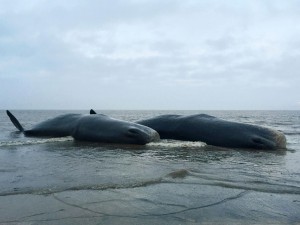Aquatic scientific names in the news …
Sperm whale
An unfortunate series of Sperm whale strandings occurred over the past weekend with one whale coming ashore at Hunstanton beach, Norfolk, and dying on Friday, a further three coming ashore at Skegness over Saturday night and Sunday morning, and one on Monday at Wainfleet in Lincolnshire, five miles south of Skegness. This comes in the wake of the 12 sperm whales that have washed up on the Dutch island of Texel and the German islands of Wangerooge and Helgoland since 11 January.
One of the great whales*, the sperm whale is the largest toothed whale and largest toothed predator; adult males can measure up to 24 metres long (average 16 metres) and weigh up to 57,000 kilograms (56 UK tons) with mature males being a third to a half longer and three times as massive as females.
Sperm whales have a global distribution but show a preference for ice free waters over 1000 metres in depth. Distribution depends upon season and sexual/social status, however they are most likely to be found in waters inhabited by squid – at least 1,000 metres deep and with cold-water upwellings. They can be seen off the north west coasts of Ireland and Scotland.
Sperm whales can dive as deep as 3,000 metres in dives lasting more than an hour. They feed mainly on squid (including colossal squids and giant squids), octopuses and deepwater fishes, but may also prey on sharks and skates; much of what is known about deep sea squid has been learned from specimens found in the stomachs of sperm whales.
Physeter macrocephalus Linnaeus, 1758, the Sperm whale or Cachalot.
Etymology
Physeter – Greek, physhthr (φυσητηρ), blowpipe or tube, blow-hole or spiracle of whales, a kind of whale.
macrocephalus – Greek, macro-, makros (μακρος), long, large; -cephalus, kefalos (κεφαλος), head; makrokephalos (μακροκεφαλος), long-headed. Loosely speaking long-headed or big-headed.
The sperm whale’s very large head represents one-quarter to one-third of the animal’s overall length.
* Surprisingly there does not seem to be a definitive meaning of the term ‘Great whale’. At best the International Whaling Commission publishes a table listing the 13 great whales, 12 baleen whales plus the Sperm whale, which suggests that criteria for inclusion is a minimum average length of 10 metres.
